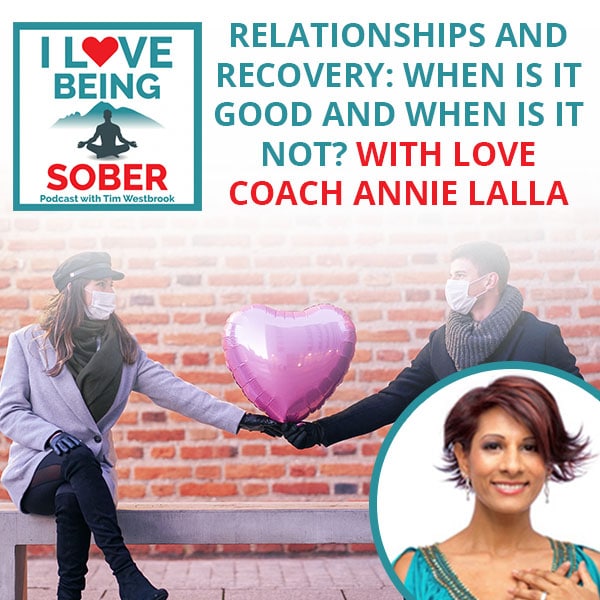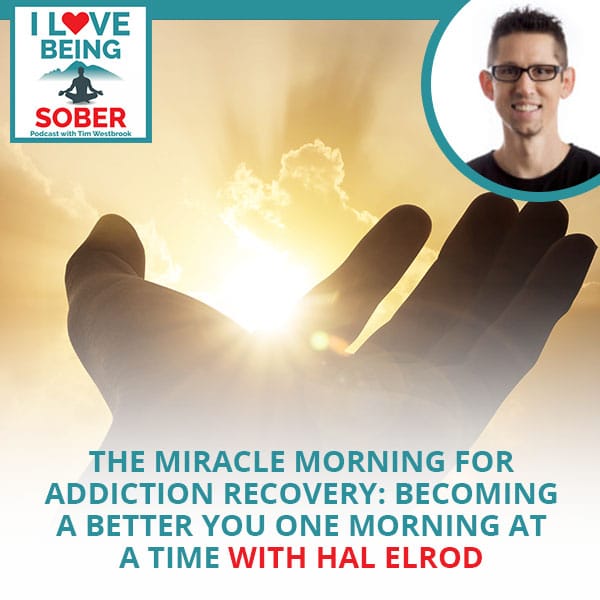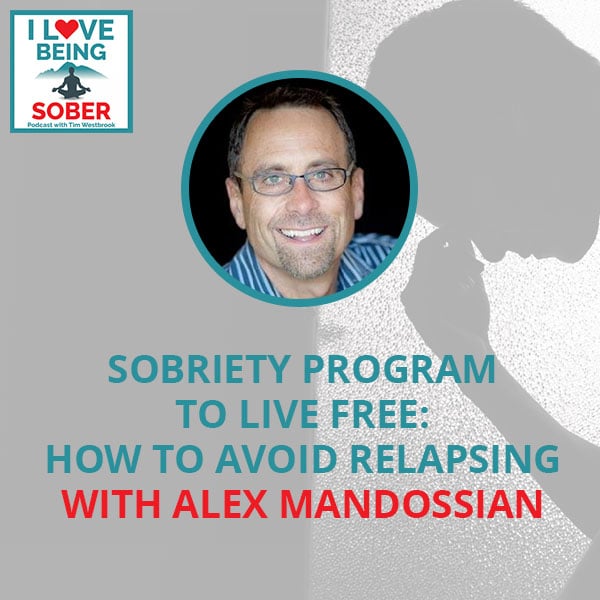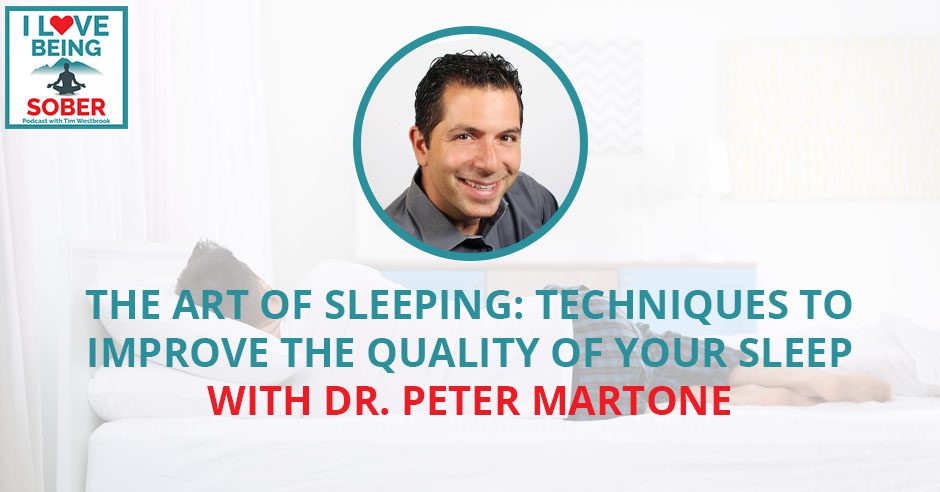
We all need proper and decent sleep to perform our daily tasks and responsibilities. If we are sleep-deprived, it will negatively affect our personal and professional lives. Discover the art of sleeping with Dr. Peter Martone. Also known as Dr. Sleep Right, Dr Martone has been a chiropractor for over 21 years, innovatively helping patients to help heal from the inside out. His techniques have been featured nationally on CBS, NBC, ABC, and Fox. He’s currently traveling the country, teaching people how to master the art of sleeping. In this episode, Dr. Martone shares these effective techniques and their impact on our everyday lives. So stay tuned and discover ways you could improve the quality of your sleep.
—
Watch the episode here:
Listen to the podcast here:
The Art Of Sleeping: Techniques To Improve The Quality Of Your Sleep With Dr. Peter Martone
We started this show because there’s so much misinformation about addiction treatment, mental illness and recovery in general. There’s so much more to recovery than just going to in-patient treatment, seeing a therapist and going to Twelve-Step meetings. All those things are important and AA saved my life.
However, to find long-term recovery and live happy, joyous and free, there’s a lot more to it than stopping the drinking, drugs, sex addiction or any addictive behavior for that matter. To live a new life, a person needs new healthy lifestyle habits. Typically, this includes new eating habits, sleeping habits, exercise habits, hobbies, new interests, new friends, self-care becomes a priority and the list goes on. Those are the types of things that we talked about here on the show.
I’m here with Dr. Peter Martone, also known as, Dr. Sleep Right. We’re going to talk about sleep and the art of sleeping. We’re also going to talk about the neurology of addiction. Dr. Martone has been a chiropractor for years innovatively helping patients to help heal from the inside out. His techniques have been featured nationally on CBS, NBC, ABC and Fox. He’s traveling the country teaching new people how to master the art of sleeping. Peter, welcome to the show. I’m so glad to have you here.
Tim, it’s an honor to be able to present in front of your group, tribe and the people that you’ve touched. Thank you so much for having me.
You and I met at the Wizard Academy. Alex Mandossian introduced us. The first time we had a conversation, I was fascinated by your knowledge about sleeping specifically and we talked about the neurology of addiction. There were so many things. You’re a chiropractor but that’s not even an accurate description of your knowledge and experience so tell me a little bit about your background.
It’s a zigzag convoluted type of background. Before your profession, why you were put on this planet, when you define yourself, people say, “I’m a chiropractor. I’m a teacher. I’m a doctor.” Whatever it may be, people identify themselves with their careers. That’s not true. We’ll go into my history but in my path to get myself where I was from a low point in my life, I had to identify myself first and then I use my business or profession to express my sole purpose. It is so important to be able to identify your true north. We’ll be diving into that and understanding why it is so important, especially for somebody that has an addictive personality to do that.
I am a person of passion. I express my sole purpose by removing the interference, connecting people to the energy of their creator and I stand for manifesting healthy lifestyle habits to help people maximize their true life potential. That is me. That is why I’ve been put on this planet. I use my chiropractic knowledge, exercise physiology knowledge, nutrition knowledge, physical therapy knowledge and I’ve put it all together over the years to be able to identify these avatars. We had talked about an avatar of addiction.
Addiction or the actual physical manifestation of what you do, the endpoint of opening up the bottle and taking a drug is a result. There’s so much more that has driven you to that point that we’re going to dive in. Yes, I’m a chiropractor, a nutritionist and an exercise physiologist but truly I’ve been put on this planet to help people maximize their true life potential.
What gives you the right to claim you are an expert in the art of sleeping?
As the zigzag may have happened, I had been a chiropractor at the point when I had met Dr. Joe Mercola but I had been a chiropractor for years. I’d always had back pain. After adjusting, helping people get rid of their pain, I felt bad like an inner self fraud because I had pain and I couldn’t get rid of it.
I attributed my pain to mountain biking, skydiving and rock climbing. I did all of these adrenaline-seeking sports. Years ago, I went off a drop, twisted the wrong way, landed, felt a tweak in my back and had herniated disc. I’m a chiropractor. I am sitting in the emergency room. My legs were numb. I’m hooked up on Dilaudid. I was at a bad place and they said, “How could it come to this?”
At that point, I thought I understood structure better than anybody. I said, “How did it get to this?” I reviewed 2,000 X-rays and found a pattern. Through that pattern, I found that I didn’t have a back problem all these years. I had a sleeping issue because the sleeping position was molding my spine the wrong way causing my back to be an issue. As my head came forward, it reacted to a psoas major muscle. I turned my lower back and it caused a weak disc due to a reaction to forward head posture. I said, “How do I fix this?”
I’ve been getting adjusted and I remember watching the movie Crouching Tiger, Hidden Dragon. When they came out of the room, they had a block of wood for a pillow. I’m like, “How can they be using that for a pillow?” I realized after doing my research that it wasn’t for the pillow. It was for their neck and they would sleep on that. It sounds uncomfortable but then they started stuffing things underneath my neck to get my head back to take the pressure off of my low back and I’ve never had a back problem again since.
After diving into that, I’m taking all of my sleep knowledge from before that and we developed all these sleep protocols. I teach people the art of sleeping and why it is so important in all aspects of your life and especially, through that addictive personality as I have it. We need to find ways to be able to spin our brains and not allow our brains to go into chaos.
When did you go to chiropractic school?
I graduated in ‘99.

The Art Of Sleeping: You have to know how to stand for manifesting healthy lifestyle habits to help people maximize their true life potential.
What made you want to be a chiropractor?
I was an exercise physiologist and was on the path to go to medical school. I was going to medical school and the summer before I was going, I had met a chiropractor. He had asked me, “What are you doing?” I’m like, “I’m going to medical school.” He’s like, “Have you ever thought about chiropractic?” I’m like, “No. I’ve done chiropractic. My father took me to a chiropractor as a child. I was in a car accident and I didn’t like it at all. I didn’t want anybody to touch my neck. I was so freaked out about it.”
After the car accident, I had ended up with acid reflux and a stomach issue. He said something like, “I can help you with that stomach issue.” It was almost going from A to Z. There were no steps in the middle. I didn’t connect the dots. He explained something to me which sets true and I explained it to my patients. I said, “If you’re watering a garden and you’re stepping on the garden hose, is that garden going to be able to flourish?” The answer is no because you’re cutting up the lifeforce to the garden. Structurally, when the spine is out of alignment, it puts pressure on a nerve affecting the function of that nerve and if that nerve goes to your stomach, there’s going to be an issue with the stomach.
I’m like, “It can’t be that simple. If it’s that simple, everybody would know it and do it.” He’s like, “Just come in.” After three adjustments. I never had reflux again. My stomach problem went away so I transferred and went to chiropractic school. I wasn’t a big fan of medicine. My whole life, I didn’t like being on the antibiotics that my parents would put me on. I was always a person of health. To come up with my sole purpose, I had to go back through my whole life and get a sense of who I was and why I was put on this planet. Chiropractic is more in line with me being able to express my sole purpose than medicine was.
Were you an athlete growing up?
I was more of that individual athlete. I played soccer but I’m more driven. I have a highland mountain biking park sweater on. I’m a mountain biker, rock climber, anything that would drive me to adrenaline. Not knowing that at the time, that’s after doing one of those sports when I was most calm or scratching my itch of trying to stimulate my brain.
Are you addicted to the adrenaline?
Without a doubt.
I’ve heard that being addicted to adrenaline is one of the first things that people are addicted to. It’s a gateway to other addictions as well. You learned about sleeping with blocks behind your head and keeping your spine straight. Did you learn any of that in chiropractic school?
No. The life you have is a puzzle. You have to put the pieces together. You have somebody saying something over here and there. You need to build the puzzle. Once you’re able to build the puzzle, you can see the picture. Through hardship and other types of things, I’ve built my puzzle, which is my technique to be able to help people. When you’re in chiropractic school, it’s part of the puzzle. It’s part of what brought me to where I was.
Chiropractic school solidified how important proper spinal alignment is to the overall mechanics of how the brain functions. To heal from the inside out, your nervous system is controlling everything so it’s so important that your nervous system functions optimally. That’s why chiropractic is such a big part of my life and my health regimen but it’s a part of the big picture.
I never heard a chiropractor tell me that being aligned is so important to so many other things in your life. I even heard you talk about ADD, anxiety and stress being related to being aligned. Do you want to talk about that for a second?
I don’t know where this is going. I am not a psychiatrist. I am a person with information that I have found throughout my life to be able to help myself. When I talk about this stuff, I’m talking about personal experience. We have worked with thousands and thousands of patients, helping them reach their optimal health and well-being in their structural mindset. I worked with a doctor named Dr. Ned Hallowell. I believe that you know him. He’s taught me so much about ADD and how the brain works.
The missing key for me through my chiropractic knowledge is understanding how body mechanics and function and spinal alignment affect brain development. That’s the missing link to me because building the puzzle, I’m looking down saying, “When I teach you the simplicity of how this functions and works, you’re going to say it like me, ‘There’s no way it’s that simple. I can do this and that alone will make me feel better not knowing why you feel better.’” That is true. Let’s dive in a little bit about how the brain works. Have you ever heard the statement, “Sitting is the new smoking?”
I have not heard that.
Lack of movement is the worst thing that you can do for your brain, body and health than anything else because if you don’t use it, you will lose it. That is applied to every aspect of your body and how it works. Let me give you an example for instance. If there’s a weightlifter that’s taken steroids, what happens to a specific body part? His balls will shrink. Most people know that. You get little balls. Do you know why that is?
[bctt tweet=”Most people identify themselves with their career.” username=””]It’s because you’re taking the steroid and the testes play a role in releasing steroids into your system so when you take in a hormone the body says, “You don’t need this organ anymore,” it atrophies. If you take thyroid medication, it will atrophy. If you take medication to overstep with the body’s doing, that organ will atrophy. Have you ever broken a bone?
Yeah.
If you put that body segment in a cast, what happens over four weeks to the structure of the joint into the muscles around it?
It atrophies because you’re not doing anything with it.
If you don’t use something in the body, you lose it. Everybody wants to support. Support weakens. It might support something but it weakens the body. I’m not a big fan of supports, arch supports and all of this stuff because the body works on laws. Wolff’s Law, Davis’s Law in the righting reflex. These are the ones that I’ve adapted to most of the avatar stuff that I’ve developed. Righting reflex says that your body posture adapts to your head position. Wolff’s Law says if you don’t use the bone, it will atrophy. Davis’s Law is the same thing. If you don’t use a tissue, it will atrophy.
What ends up happening is we have this body that is constantly adapting to everything that we’re doing at every single point in our life. You take that and look at brain neurology. If we don’t use our bodies, our brains will atrophy. With addiction, there’s a specific part of the brain that you need to be concerned with. That portion of your brain is called Vermis. There’s something that’s called proprioception. When there’s a lack of proprioceptive senses going into the brain, the vermis in your brain atrophies.
Why does that have any correlation? How does that have any correlation to addiction? When you google and you can go on Wikipedia, it says that one of the main functions of the vermis is to build a healthy, strong prefrontal cortex. Do you know what the prefrontal cortex is? Do you know why that is so important in addiction? That is where your rational thought is and where your breaks are. It’s like, “I’m going to eat this pen.” No. It’s not a good idea to eat this pen because your brain rationalizes that and told you to stop.
With addiction, it is important to do everything you can to build a strong prefrontal cortex so you can make good decisions. If you have a weak Vermis, you have a weak prefrontal cortex. Ned Hallowell explains, “You’re like a Ferrari with bicycle brakes. You have this machine, this brain that has so much potential energy that you’re trying to slow down with breaks, you’ll blow right through and you’ll make bad decisions for the rest of your life.”
When I first met you, you did this thing where you had me look at you and you held up your hands. You looked at my right eye then at my left eye and said, “Are you right-handed or left-handed? Do you kick with your right foot or left foot?” You then said, “You have ADD.” You went to the next person and you did the same thing. You said, “You have ADD.” For the next person, “Nope, you don’t have it.” Tell me about that.
We’re touching the tip of the iceberg. I like to talk in the 350-foot view and give you concepts that make sense to the layperson. We’re going to talk about building the vermis, why it’s so important and how to do it. We’re going to talk about building the prefrontal cortex and how that all links to addiction. I’m not going to talk about just the ADD brain. Picture this, you have a top and you spin it. The faster the top goes, the less wobbly it is. The slower the top goes, what happens to the top? It wobbles. In our brain, it would become more anxious. The faster it spins, the more focused you are and the less anxious you are.
We do things to spin our brains, whether it’s stimulants or adrenaline. The addiction brain requires a lot more spin than the person driving 5 miles per hour under the speed limit and you want to pass them. It’s the button in front of them. They have a lack of attention. There are two different types of brain, one requires a lot of spins and one doesn’t require as much spin.
The ADD brain requires more spin to keep it focused. The non-ADD person doesn’t need as much spin. They have lots of attention. They can focus. They don’t need a lot of spin, action or stimulus to focus.
You’ll notice if somebody is doing this with their fingers or running their legs, they’re stimulating their brain to focus. They’ll usually do that while sitting at a dinner table. When they get bored, their fingers will start to move because those are overflow movements that are trying to stimulate their brain to keep them focused.
In ADD brain or addicted brain, it wants a lot of noise to study versus somebody that has the attention surplus to so they’ll get distracted with the noise. The distraction to the ADD brain keeps it focused. All they’re doing is requiring them to spin. On a computer, there’s a program called defragging your hard drive. What it does is it puts all the files in the right places so the computer can run more efficiently.
There’s a portion of your brain called the corpus callosum, which is in the middle. It’s designed to attach the right side of the brain to the left side of your brain. It makes these cross fiber formations. The addictive personality of the ADD brain usually has an issue with that corpus callosum. The right side and the left side don’t talk. Like a defrag hard drive, it takes a lot more for them to be able to get the spin going because the brain isn’t communicating correctly. A good quick way to evaluate if somebody has a corpus callosum issue is to identify their lateralization. Are they fully lateralized? Most people should be right-handed, right-footed, right-eyed and right-eared dominant.
Typically, you’ll notice somebody with an addictive personality or the ADD brain will be right-handed but they kick with their left foot. They’ll say, “I play golf lefty but I use a tennis racket with my right hand.” That’s why I had you look at me through a circle and bring it back. I am right-eye dominant. A quick way to analyze if somebody has that corpus callosum issue is to figure out if they’re fully lateralized. There are a few tests that you can do to do that.
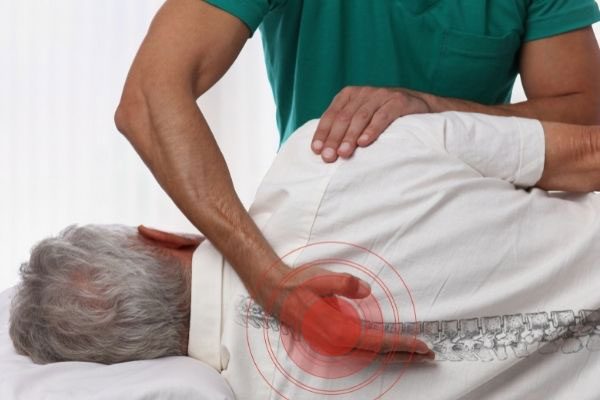
The Art Of Sleeping: Chiropractic school really solidified how important proper spinal alignment is to the overall mechanics of how the brain functions.
How accurate is that test?
It’s 100%. Everybody has a dominant hand. Typically, they have a dominant leg and ear. If you’re going to listen to a phone, which ear do you typically go to first? If you’re going to write which hand you write with, typically. If someone’s like, “I can use both hands,” they have a cross dominant.
I’ve never seen anyone test for ADD in that way before but you were spot on with all of the people that I saw you do it.
It’s not 100% for a diagnosis. I have questions that I asked based on the avatar that I’ve built and that is one of them, which puts you into a category where I know where my questioning needs to lead once I know that those things are an issue there. It’s all neurology. It’s not a disease. You have that personality, whether you use it to crave it through addiction or you do it through being a workaholic or through exercise.
Your brain can get 100 times more accomplished than a different brain but you can go enthusiastically in the wrong direction and end up somewhere where you don’t want to be because you’re scratching an itch. Another thing would be craving carbohydrates. The ADD brain can self-medicate itself with carbohydrates because your stomach releases Gluteomorphin when you have gluten, which is a morphine derivative that goes up to the brain and makes you addicted to it. There are all of these different things that are tied in but when you break it down simplistically, the body’s trying to spin the brain. Whatever you choose to use to spin that brain, you can be destructive or it can be constructive.
You talk about carbohydrates and ADD. A lot of people do keto, paleo, high fat, high protein and low carb. I’ve done that but for me, I find that I need complex carbs. My body doesn’t do well on the keto diet. Does that have anything to do with ADD?
I slipped a word in there when I shouldn’t have. Gluteomorphin is a morphine derivative, which is released when you eat gluten. Salads are all carbohydrates. It’s the Gluteomorphin. There’s also Galactomorphine through dairy products but more specific gluten is what you’d be. You don’t have to be in ketosis. We’re going to go back to this because there’s something that we skipped in the neurology. Anything that messes up brain spin is going to make you more anxious. It’s going to be more wobbly.
When your body burns carbohydrates, it’s like burning wood to heat your house. It’s very sudsy and there’s a lot of byproducts from burning wood. When your body releases and breaks down carbohydrates for energy, there’s a lot of byproducts that can be inflammatory, which can also affect brain spin. When you break down ketones, which is the byproduct of fat metabolism for energy, it’s like burning propane.
It’s a much cleaner energy source that has much fewer byproducts that doesn’t interfere with the brain spin. You need to have both but when you have a higher carbohydrate diet, you’re going to be more likely to slow the spin down in the brain. We’re not talking about health. We’re talking about neurology and what is healthy food for the brain to fire.
Is that why when people eat heavy carbs they’re more likely to be sluggish because of the byproduct?
Yeah. That’s also byproducts and you’re releasing insulin, then you have a crash. Burning fat or eating fat is more a time-release capsule of energy versus loading sugar right into the bloodstream.
You told me to get a wobble board and practice on the wobble board, which I have the wobble board. You said, “Get to 10 seconds and let me know when you get to 10 seconds.” I’m pretty much at ten seconds. It’s a lot harder than people think. Go get yourself a wobble board if you want to try it out. I’ve had lots of people try it. I remember I had my nephew stand on it and I was like, “He’s not going to be able to do it. He knows what I’m thinking.” He sat on that thing forever and he does not have ADD. I have a pretty strong core and I’m like, “I should be able to do this. No problem.” It’s because of my lack of focus. Talk to me about the wobble board here.
That’s such a great segue into what we skipped. We talked about how it’s all neurology. I look at things, neurologically. I have to do my research and know what fits into it. If it doesn’t make sense to me based on this avatar that we’ve created, I don’t believe what people tell me. When we go back, we talked about the spin of the brain. We talked about the atrophy of the vermis. Typically, the addictive brain is going to have a smaller vermis or an undeveloped vermis. It looks at a child versus an adult or an elderly person. What does an elderly person infant have in common? They both wobble and are all over the place. They lose their gait so they’re unbalanced.
An infant has an undeveloped brain and an elderly person has an atrophied brain. I don’t know where you stand but look at the way Joe Biden walks. He has shuffles, gaits and trips all over the place. That tells me he has an underdeveloped vermis and he has a prefrontal cortex or executive functioning issue based on the way of watching him walk. You don’t need the cognitive test.
I already know what his cognitive ability is by looking. That’s the avatar and neurology. Let’s look at what builds the vermis. That should be the next question because a lot of people work on the prefrontal cortex and try to goal set and meditate, which is all-important but if you don’t get the structural issue of what’s causing the atrophied vermis, you’re always going to have an issue.
What builds the vermis? When you google it, it’s proprioception. You’d say, “Strong core.” I’d say, “An innovated core.” You’d say, “My core is strong.” You are consciously trying to do sit-ups and work on it but you’re only working on it to make it strong. If it’s uninnovative, it doesn’t matter. I was working out all the time and I still have back pain. Uninnovative is you’re only in control 5% of the day. Ninety-five percent is what happens in the subconscious brain. You need to train your brain to get out of pain and address your addiction in a focused way.
[bctt tweet=”If you don’t do something in the body, you’ll lose it. ” username=””]Eight percent of all proprioceptive signals are housed in the spine. The spine has 80% of all the proprioceptive signals. A majority of those are from your shoulders to your neck. I looked at X-rays. When I say degeneration and I see a lot of issues with the neck that affects the range of motion, the way that the neck moves and how fluid it is, I know you have an underdeveloped brain. I know that the balance is going to be so hard for you because your neurology is screwed up. That is why you want to maintain motion, open up that space and get on a wobble board. When you’re able to do it, then I know neurology-wise that we can move forward with other stuff to work on.
Looking at somebody, taking a look at X-rays and stuff like that, I know how bad it’s going to be, how hard it’s going to be and how humbling it is for them. I used to work with Tomic from the Bruins, helping them with hand-eye coordination. I had him on a wobble. He’s like, “Why am I doing this for?” It’s because you need to build the brain to have good hand-eye coordination. It’s all neurology to me. It’s all in the brain.
The wobble board is to build the vermis.
It’s not to build the prefrontal cortex but that’s a byproduct of building the vermis. It helps stimulate and develop the vermis. We are in the development of having a specific wobble board that you’ll have these interchangeable bases. When you’re able to master it, you’re good.
How often should I be practicing on this wobble board? Sometimes, it’s humbling. I can only do it for a couple of seconds at a time. I do get there but sometimes it’s hard work.
Where you were in your life to where you are is that easy work to get to where you are? No. You’re re-firing in the neurology of your brain to me, which is at the core issue. It could take months and months. Do it as much as you can. I ended up getting a unicycle back in the day to be able to work with my balance. That’s how important balance is to me.
What are some other ways to build the vermis besides the wobble board and the unicycle, which sounds hard?
You work on your vermis. Where does 80% of all Proprio signals in the body house? It’s in the spine. That’s why chiropractic to me is important to get adjusted regularly because you break up the scar tissue, which is a cast within that joint. When you atrophy the joint, you decrease proprioceptive signals and you atrophy the brain. It’s the same thing. That’s why sitting is the new smoking. When you atrophy and sit down on a couch all day long, you’re decreasing proprioception and you’re atrophying the brain and everything else goes along with it.
Chiropractic care, along with working on balance and the third thing I’ve mentioned but I skated over it a little bit but we’ll go back to it is adopting healthy sleep posture, not sleep position. My whole life even before I was a chiropractor, I was a back sleeper. I tell people, “What position do you sleep in? Side, back or stomach?” Most people sleep on their side, which screws up your spine. If you’re going to sleep on your side, you’re going to have a shoulder problem, a hip issue, a knee issue because the body adapts to the stresses that you put on. If you start on your side, you’re going to toss and turn all night long.
I want to be able to put you in the proper sleep posture that you can because through the righting reflex, the body position follows. Your posture adapts to your head position. If your head is out here like this, your whole spine is going to proprioceptively break down and you’re going to end up with scoliosis and these adaptive curves that are adapting that I know to your poor sleeping position. When you sleep, you want to put yourself into a position like Crouching Tiger, Hidden Dragon where a pillow isn’t under your head but a pillow defined as a support for your head.
That is why I call the new product that we develop the Neck Nest because I want people not to think of a pillow where they’re supporting their head. I want them to get a block of wood underneath their neck. A rolled-up towel, sock-down support and you want to get that head back because it’s difficult to balance with the head out here. You want to balance with your weight equally distributed over your hips. When I put people into this proper sleep posture, I want people lying back, I want them to take some pillow or some sleep support and put it under their neck. It’s supporting the arch in my neck and that is the posture that you want to have.
If you set yourself up at night and your weight is distributed over the greatest surface area, you’re going to have to get over some airway issues and there’ll be some different techniques that we teach on our online platforms to be able to help people sleep better. If you’re able to start in that position for 1 to 2 hours a night, the head will start to come back. You get adjusted and increase the range of motion by breaking up scar tissue on the spine. You get on a wobble board, you then decrease the number of carbohydrates you’re eating and you increase more of the fats.
You go more intimate and fasting where you eat in a window of 6 or 7-hour eating window from 12:00 PM to 7:00 so you’re not getting all of that food into your system. When you start spinning that brain with that balance board and things like that, you will feel better by doing those things. Everything else you’re trying will be and feel so much easier because you’re not fighting yourself with your lifestyle.
You and I talked about sleeping. You looked at my aura ring and my data from I don’t know how far you went back. You said, “You’re not sleeping enough.” What is enough?
As far as I am concerned, as a sleep expert, that’s probably one of the most consistent questions I’ve been asked. With my mindset and knowledge of trying to understand the neurology and your read of 8 to 9 hours, “I can get away with six. What is the difference?” Is there a way to analyze how much sleep you need? My answer to that question is, “There is.” You can use something that’s called Heart Rate Variability. Heart rate variability is the way that your heartbeats. The ADD, addictive or whatever you want to call it brain tends to be sympathetic dominant which means you’re always ready to run from a tiger. You need that stimulation.
In retrospect, I see that your logo has somebody meditating. Meditating would be parasympathetic dominant, which is a more restful growth, calmer place to be healing in the development portion of the body. For you to heal in function, you can’t be in survival, which is where the addicted brain lives so they’re always reactive. That is why it’s a great logo. It says, “Work on your physiology. Bring that brain down.” MC is what we’re going to be calling our new wobble board, the MC Wobble Board, Mind Control. Control your mind and all else will follow.
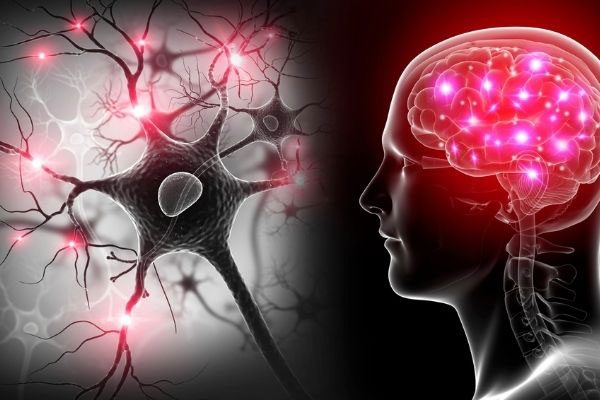
The Art Of Sleeping: In order to heal from the inside out, it’s important that your nervous system functions optimally.
There is a way through different rings and things to sensors that you can put on your body where you can see what your heart rate variability is in the morning. The heart rate variability tells you if you are sympathetic dominant or you’re parasympathetic dominant, if you’re running from a tiger or you’ve rested and relaxed because rested and relaxed is where all growth comes from. I had a party and it’s horrible. I went to bed at 3:30 AM. I never go to bed at 3:30 AM. I got eleven hours of sleep last night because of my restriction. My HRV was a 7 from 0 to 100. That was seven points away from being dead. That’s how bad my heart rate variability was.
When I stay at seven, I know how bad that was. I went to bed at 6:50 PM because it was so bad. I knew that I sacrificed my sleep. What you do is you understand how you feel. In order for me to feel good on a day like this, my HRV based on my averages needs to be where it is. When it’s 19, 16, 10, 20, I feel horrible. I determine how much sleep I need depending on the energy I want and then I have justified the HRV readings I want from that. When I look at people’s stuff, I look at the variability, your best days and when you had your highest readiness and then I see what those HRV readings are. I come up with how much sleep you need off that.
I remember when I was talking with you, you looked at my Oura Ring and you said, “You’re not getting enough sleep.” I’m like, “I feel great.” In our conversation, I also told you that I was taking thyroid medication. You laughed and said, “It’s because you need more sleep.” That was one of the biggest things for me. I had comprehensive bloodwork done.
Dr. Rebecca Miller looked at my blood work and she said, “Your thyroid is not functioning at 100%. I’m going to put you on thyroid medication. You probably can’t tell now but in 90 days, you’re going to feel a lot better.” Sure enough, 90 days later, I felt so much better and I had way more energy. I went from needing 7 to 8 hours of sleep and then I need 6 to 7.
You still need 8.5 to 9 hours of sleep. You think you’re getting away with it because you’re taking the support. If I’m watering your garden stepping on the garden hose, what’s the health of the garden going to look like?
Not good.
The major innovation to the thyroid just so happens to be the most amount of your degeneration is in your neck. It’s no coincidence to me that you have atrophy compressing the nerve that goes to your thyroid. Your thyroid function to me is directly related to the pressure that’s been on the hose your entire life. Let’s look at taking support for the thyroid. What’s going to happen to the function of the thyroid taking support? You must feel better because you’re taking something to make you feel better.
You need to do it when you want to feel better but we must understand and backtrack the major cause that got you here. Lack of sleep and degeneration of the nerve that directly integrates the thyroid. Even though you’ve taken the medication, you still want to work on uncompressing that nerve. That’s why it’s important to work on balance, sleep position and get yourself adjusted.
I wake up early. I’m up at 4:00 and I couldn’t even sleep any longer. Sometimes I wake up at 3:30 to 3:45. I look at my clock and it’s like, “ I’m not going to go back to sleep. I’m not going to get any good sleep. It wouldn’t even be worth it for me to go back to sleep so I’m just going to wake up.” How do I get myself to sleep more if I feel like I don’t need any more sleep?
It’s the Oura Ring that does your heart rate variability in the morning. You’d want to take a monitor and monitor what your heart rate variability is throughout the day. That’s how you would dive into something like this. You’d want to see what it looks like because the thyroid lives in the parasympathetic realm. Being awake lives in the sympathetic realm.
Even though you’re awake, you’re being stimulated somehow through the sympathetic nervous system, probably releasing adrenaline in the system. Your awake hormones are suppressing your reproductive system, digestive system and immune system. Those are all parasympathetic systems. What I would want to do is I’d want to see what it looks like and then do things to stimulate. Did I send you Deep Sleep? Did you try that?
I did try the Deep Sleep. If I remember correctly, I got more Deep Sleep as a result of it and I was going to order more.
You want to backtrack and look at it but the body works on the lost. You can only be sympathetic and dominant for so long. Everything else gets deteriorated slowly over some time. You might feel good now but what are you pushing down the road as far as I’m concerned? The avatar that we’ve built is a balanced lifestyle. To me, sleep is critically important in that. That’s why we have the sleep programs online where you do-it-yourself type of stuff. I teach people all this stuff and how to do it. It’s a very inexpensive program.
I work with somebody one-on-one. That typically isn’t financially conducive to a lot of people. If you can understand that your body’s neurology works like this, you have a nervous system which is called your autonomic nervous system, it’s controlling everything, that’s the nervous system you need to nurture. If one organ is off, we need to understand what’s causing it to be off and then understand how we backtrack that to improve the function of what it is that you’re working with.
You would say, “How do I get more sleep?” You come up with different patterns. Shut down the lights in your house, put your temperature in a specific way and shade block. Once you’re up, you’re going to have a difficult time falling back asleep because your brain is in that addictive thinking. You must learn how to shut those things off. I give different techniques on how to do that.
How important is it for someone to know to have an Oura Ring or a Whoop to know their HRV, deep sleep, light sleep and REM sleep? How important is it for somebody to know their sleep data?
[bctt tweet=”You can’t go a lifetime being sleep deprived. Sleep is critically important in being able to work on fundamental pillars.” username=””]I’m under the mindset that you can’t improve what you don’t monitor and track. It’s super important. I have these things on our chiropractic website, which is AtlantisWellness.com. If you go there, there’s an article there called The Pillars of Health. The way that I came up with those is what can your body live without for the least amount of time. Breathwork is important. You can only hold your breath for a certain period before you die.
Hydration, you can only go without water for a certain period. Food, you can only go without food for a certain period. Sleep, you can only go without sleep for a certain period but you can go a lifetime being sleep deprived. You can go a lifetime being dehydrated. All these things that we take for granted are the basis of what we must get back to. Sleep, to me, is critically important in being able to work on these fundamental pillars. Whatever health-related issue you have, more than likely is associated with one of the pillars.
Do you recommend an Oura Ring or a Whoop? Do you think one of those is better? Do you think they’re comparable?
Some people have better results with the Oura and some people have better results with a Whoop. If they have a membership or don’t have a membership, there are other things that you can use. You need to track your sleep. Fitbit might do one and Apple Watch may do it. I tend to know Oura Ring better because that’s what I use. Anything that you’re tracking is good. Both of them have heart rate variability. What you do is you use it and wear it for 1 or 1.5 months and then look at the data. Anything that improves the data is something good and then you look at different lifestyle stuff that you do and monitor. That’s all.
I’ve got a couple of questions here. Going back to the vermis, how do you know if your vermis is weak?
Get on a wobble board. If you can’t stand on it, your vermis is weak. When you support something, you’re going to weaken something else. If you have any degeneration in your spine like arthritis, your vermis is weak because you’re decreasing proprioception in the spine. If you walk with shoes, which most people wear, I wear shoes, if a flat surface on a hard floor decreases proprioceptive sense, your vermis is weak.
Our life is conducive to a weak room. If you sit in a chair all day long, your vermis is weak. That’s why it’s so important to offset the degeneration that happens in the brain to maintain healthy cognitive function. Always from now and for the rest of your life, you need to work on building your brain and your balance.
Let’s go back to The Neck Nest and sleep on your back because you told me about sleeping on your back. I know one person that sleeps on his back. I remember the first time we talked. You said you could sleep on your back and you can have a cup of coffee or an apple on your stomach. When you wake up, it’ll still be on your stomach. It sounds crazy to me because I sleep on my side and I put a pillow between my legs. I do roll over throughout the night. How do you go from being a side sleeper to sleeping on your back?
That’s probably one of the most challenging things that we have in our sleep community. People are asking that same question. It takes self-discipline. Remember, like you not being able to be on a wobble board, you can’t because your neurology has built these rivers of comfort and consistency. If you kick out a dam at the top of a mountain, the water will flow. After weeks and months, it’ll create these channels and rivers. Your brain works the same way. You have learned neurological patterns, that the longer you’ve been doing that for, the tougher it is to the river.
These neurological patterns are very difficult because you’re addressing the subconscious brain. People will say, “Doc, I can’t sleep in that position.” You don’t have to sleep in that position all night. You need to be in that position for 1 to 2 hours a night. Whenever it happens in the middle of the night, 1 year, 2 years later, 1 month, 2 months later, 1 week, 4 weeks later, your body will end up getting used to that position because neurologically, it will turn less and less as you stay more comfortable with it. It’s so important not to put a pillow under your head but to support the arch in your neck when you are lying in that position. Even if you only do it for 1 to 1.5 hours at night, that’s fine.
You need to start doing it. It’s similar to sleeping with tape on your mouth. You start with tape on your mouth, eventually, you take it off and then you can sleep the entire night. Let’s talk about tape over the mouth. Does that mean anything to you?
You don’t want to be a mouth breather. That affects the brain and oxygenation in your mouth. We were supposed to be able to suck our tongue to the roof of our mouth and keep our mouth shut. A lot of people breathe out of their mouths and they’re mouth breathers. To retrain the body to be a nose breather, you’ve got to do different stuff like that. You can put tape over your mouth. I teach people to put the covers underneath the chin to keep their mouth shut and different things like that. Remember, you only need to be in that position for an hour a night, then go to your side. As you do it more and more, your body will get used to it.
The key is taking a flat pillow, rolling it up supporting your neck or getting The Neck Nest from you, which is probably the easiest thing to do. Start that way. One of the reasons people don’t sleep on their back is they say, “If you sleep on your back, you’re more likely to snore.” Is that true if you use neck support?
Your airway will be opened more by using neck support. You breathe better but you can still snore more when you’re lying on your back. That’s why we teach people to use a bed wedge, which would let you sit slightly elevated. That will make you snore less. Tape over your mouth, something underneath the chin. They make all these snore devices that you can use but you’ve got to retrain the body how to breathe while you’re sleeping. Those are things that come up the longer you stay on your back. I want people to think 1 or 2 hours a night and that’s it.
Is there anything that you wanted to be asked but I forgot to ask you?
I was writing stuff down as we went over this. We covered everything. We didn’t go into my deep story. Understanding that there’s nothing wrong with you and understanding that on contrary, you have more potential than the person sitting next to you that doesn’t have that type of brain that you have. If you want to take that race car engine for a brain, stop to build the brakes and put it in the direction in life that you’re trying to go and then you’ll be able to accomplish so much more than most people.
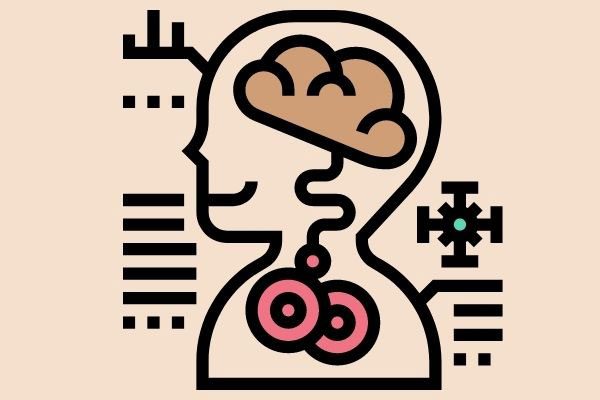
The Art Of Sleeping: If you don’t get at the structural issue of what’s causing the atrophied vermis, you’re always going to have an issue.
How can people learn more about you? How can people follow you? How can people find you if they want to find you?
Things are being developed in the Dr. Sleep Right stuff but they can go on Facebook and look up Doctor Sleep Right. They can also look up Neck Nest. They can go there and ask me questions. We’re on Facebook, Instagram and all that type of stuff. Those would be some good places to start. If you have any direct questions, go email CustomerService@NeckNest.com. Start to join our live talks that we do on Facebook and stuff like that.
You mentioned a sleep program that you offer.
The sleep program is on NeckNest.com. It’s $199. It’s a 30-day sleep challenge. That 30-day sleep challenge is one video a day for 30 days with me explaining everything that you need to know about sleep but it would still be up to you to make the changes.
Dr. Peter Martone, thank you so much for your time. I truly appreciate you. I got value out of our conversation and I’m sure lots of other people did as well.
Thank you so much for having me. I appreciate you.
Important Links:
- Dr. Peter Martone
- Dr. Joe Mercola
- Dr. Ned Hallowell
- Neck Nest
- Oura Ring
- Whoop
- AtlantisWellness.com
- Fitbit
- Apple Watch
- Doctor Sleep Right – Facebook
- Neck Nest – Facebook
- Instagram – Neck Nest
- CustomerService@NeckNest.com
- NeckNest.com
About Dr. Peter Martone
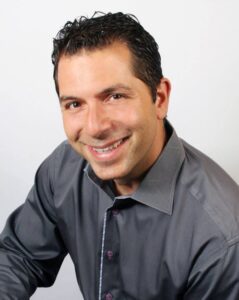
Dr. Peter Martone has been dedicated to creating the happiest, healthiest most well-rested tribe of people on the planet for over the past 20 years. He is the owner of Atlantis Chiropractic Wellness Centers and the inventor of the Neck Nest, a revolutionary new pillow that is designed to improve your posture while you sleep. Dr. Martone’s techniques have been featured nationally on CBS, NBC, ABC and FOX news stations and currently travels the country teaching people regain their health by mastering the art of living a healthy lifestyle.
